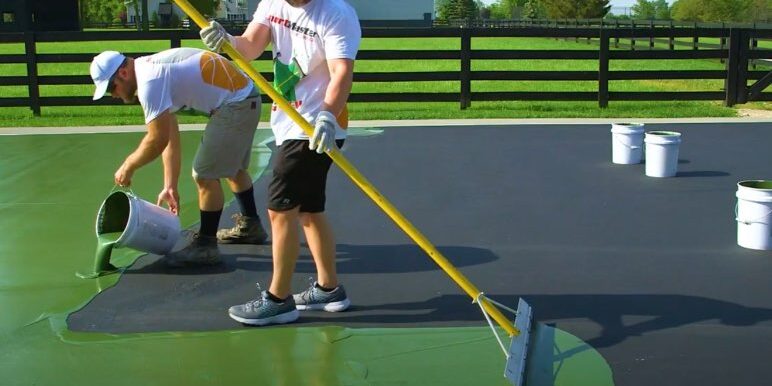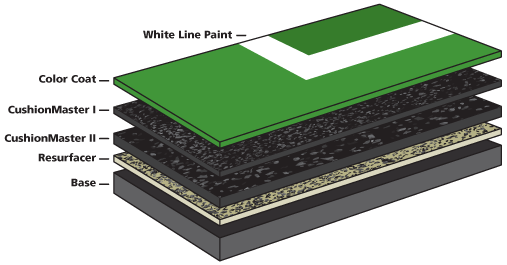Economical Pickleball Court Construction for Homes and Communities
Economical Pickleball Court Construction for Homes and Communities
Blog Article
Sustainable Practices in Pickleball Court Building You Should Know
As the popularity of pickleball proceeds to climb, so as well does the requirement for sustainable techniques in court building. This method not just addresses ecological worries but likewise enhances the durability and functionality of the courts. From choosing environmentally friendly products to implementing reliable drain and energy-saving lights solutions, there are numerous approaches to consider. Yet, the influence of these methods prolongs far beyond the court itself. Understanding how each component adds to a much more sustainable future welcomes additionally exploration into the elaborate equilibrium between leisure development and ecological stewardship.
Selecting Eco-Friendly Products
Selecting green products is a critical action in the building and construction of sustainable pickleball courts. The option of sustainable materials not just lessens environmental impact yet likewise boosts the long life and efficiency of the court. Key materials consist of recycled rubber for the surface area, which provides excellent durability and shock absorption while drawing away waste from land fills.
Furthermore, making use of locally sourced products decreases transport exhausts and supports local economic situations. Pickleball court construction. Using native hardwoods for fencing and seats can offer a lasting visual while guaranteeing durability against the components.
Incorporating absorptive materials for court structures can better add to sustainability by permitting all-natural water drain and reducing drainage. These selections not just safeguard local ecological communities but likewise promote healthier play settings.
Effective Drain Solutions
While the option of green products is essential, implementing effective drainage solutions is equally essential for maintaining lasting pickleball courts. Correct water drainage not only safeguards the court surface from water damages yet likewise minimizes erosion and runoff, promoting ecological honesty.
Efficient water drainage systems can include absorptive paving, which enables water to penetrate the ground as opposed to merging externally. This reduces the possibility of standing water, which can bring about mold and mildew and other upkeep issues. Furthermore, incorporating strategically positioned drainage networks and swales can direct excess water far from the court area, ensuring a completely dry playing surface area and avoiding dirt disintegration.
Using indigenous plants in the landscaping around the courts can further enhance drainage by taking in excess water and decreasing overflow. These plants need much less irrigation and promote biodiversity, straightening with sustainable practices.
Furthermore, it is critical to frequently preserve the water drainage system to ensure its lasting effectiveness. This includes clearing up debris and tracking for blockages. By focusing on effective water drainage solutions, pickleball court producers can significantly add to the sustainability and longevity of the center, ultimately benefiting both gamers and the setting.
Energy-Efficient Lights Options
As the need for imp source pickleball remains to grow, integrating energy-efficient lights alternatives into court style has ended up being increasingly vital for sustainability. Typical illumination systems usually consume extreme energy, adding to higher functional costs and environmental effect. Adopting contemporary, energy-efficient technologies is important for both brand-new building and constructions and restorations.
LED (Light Emitting Diode) illumination sticks out as a top option due to its longevity and power cost savings (Pickleball court construction). Compared to standard illumination, LEDs use approximately 75% much less energy and can last approximately 25 times longer, dramatically minimizing upkeep prices. Moreover, the directional nature of LED lights reduces light air pollution, guaranteeing that illumination is concentrated on the court as opposed to surrounding areas.

Lasting Surface Alternatives
Exploring lasting surface area choices for pickleball courts has obtained grip amongst home builders and gamers alike. The emphasis on environment-friendly products not only straightens with the growing environmental awareness however also improves the performance and longevity of the courts.
This product offers superb shock absorption, lowering the danger of injuries for gamers while promoting sustainability. These floor tiles are easy to change and set up, and their flexibility allows for different court arrangements.
Natural lawn courts are additionally arising as a lasting choice, promoting biodiversity and lowering the heat island effect. They need normal maintenance and water, which may not line up with all sustainability objectives.

Water Conservation Strategies

Another efficient technique involves the installment of rainwater harvesting systems. These systems save and accumulate rainwater for usage in keeping court surfaces and landscape design. This approach not only preserves potable water however additionally reduces reliance on community resources.
Furthermore, using drought-resistant landscaping around the courts is necessary. Native plants require less water and are much better adapted to regional environment conditions, thus reducing total water consumption. Furthermore, using reliable watering systems, such as drip irrigation, makes sure that water is supplied directly to plant roots, lessening dissipation and waste.
Conclusion
Incorporating lasting methods in pickleball court construction substantially contributes to ecological conservation and resource performance. By prioritizing these practices, the building of pickleball courts can line up with more comprehensive environmental objectives while advertising durability and performance within communities.
As the appeal of pickleball proceeds to increase, so also does the need for sustainable methods in court building and construction.Choosing environmentally friendly materials is an important step in the building of lasting pickleball courts. By focusing on energy-efficient illumination alternatives, pickleball court erectors can contribute to a more sustainable future while meeting the requirements of stakeholders and gamers alike.Including sustainable surface options not only improves the performance of pickleball courts however additionally paves the method for executing effective water conservation methods.Including sustainable practices in pickleball court construction significantly adds to environmental conservation and source performance.
Report this page